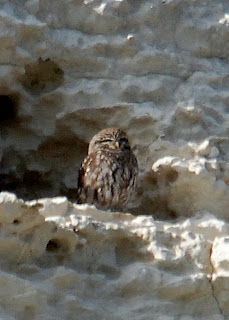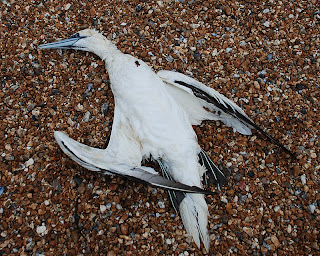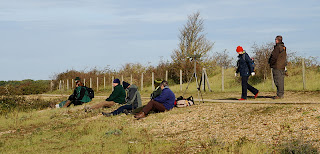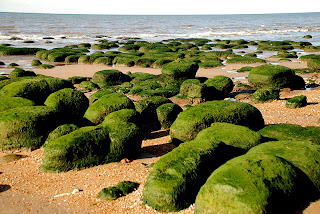A couple of female snow buntings in the stubble on the cliffs were the highlight of sunday morning and a rough legged buzzard floating over Lydden hill on sunday afternoon was even better.
The moth trap hasn`t been out lately but the last few nights its been on and here are some of the autumn favourites.
GREEN BRINDLED CRESCENT
BLAIRS SHOULDER KNOT
FEATHERED THORN
YELLOW LINED QUAKER
NOVEMBER MOTH
Wonderful names as ever.
Monday, 31 October 2011
Thursday, 27 October 2011
STRANGERS ON THE SHORE
After the hectic week in Norfolk it was back to the patch on monday,with an after lunch stroll around Langdon cliffs,nothing much to report from there,but a call from Steve Ray had me scurrying down to the Prince of Wales pier where he had seen a GREY PHALAROPE,it was not immediately evident when I got there,but it soon appeared again ,I had forgotten how small they are,superficially like a tiny black headed gull,it was in the shadow of the pier picking morsels of food from the surface.The birds breed in Iceland and spend the winter at sea off the coast of west Africa.
GREY PHALAROPE
GREY PHALAROPE is also known as RED PHALAROPE as in breeding plumage it becomes a deep terracotta red.
A single PURPLE SANDPIPER was also found on the beach opposite the Gateway flats,this bird also breeds in Iceland and other Arctic regions,it spends the winter in small groups feeding amongst rocks and seaweed covered surfaces,there used to be a group that regularly wintered on the hoverpad but this has diminished over the last few years,now preferring the new rock sea defences at Hythe.
PURPLE SANDPIPER.
A few bits and pieces from Tuesday at Samphire Hoe;
PIED WAGTAIL resting on the wall.
WHEATEAR migration has slowed to a trickle now.
ROCK PIPIT numbers are building up,can reach 30-40 birds in the winter.
GOLDFINCH flocks have been on the move recently foraging on teasles and thistles.
The troglodyte LITTLE OWL has returned to its cave on the cliffs.
A less pleasing find on the beach near the clock tower today was a dead gannet,there was no obvious injury so it may have died of starvation,but that is not certain.
This gannets 6 foot wing span will never take to the air again.
The gannets large webbed feet are lined with pale green ribs,something you rarely see.
The more I look at this poor beast it does look quite emaciated but that may be because it was very wet.
GREY PHALAROPE
GREY PHALAROPE is also known as RED PHALAROPE as in breeding plumage it becomes a deep terracotta red.
A single PURPLE SANDPIPER was also found on the beach opposite the Gateway flats,this bird also breeds in Iceland and other Arctic regions,it spends the winter in small groups feeding amongst rocks and seaweed covered surfaces,there used to be a group that regularly wintered on the hoverpad but this has diminished over the last few years,now preferring the new rock sea defences at Hythe.
PURPLE SANDPIPER.
A few bits and pieces from Tuesday at Samphire Hoe;
PIED WAGTAIL resting on the wall.
WHEATEAR migration has slowed to a trickle now.
ROCK PIPIT numbers are building up,can reach 30-40 birds in the winter.
GOLDFINCH flocks have been on the move recently foraging on teasles and thistles.
The troglodyte LITTLE OWL has returned to its cave on the cliffs.
A less pleasing find on the beach near the clock tower today was a dead gannet,there was no obvious injury so it may have died of starvation,but that is not certain.
This gannets 6 foot wing span will never take to the air again.
The gannets large webbed feet are lined with pale green ribs,something you rarely see.
The more I look at this poor beast it does look quite emaciated but that may be because it was very wet.
Wednesday, 26 October 2011
TIME AND TIDE or THE WASH UNPLUGGED
Friday,the last day of the Norfolk trip had been earmarked for Snettisham,the RSPB reserve beloved of TV documentaries where millions of waders come to roost when the tide pushes them of the muddy shores of the Wash.It was the best day of the week weatherwise and I think more species of bird were seen here than the other venues including scaup, spotted redshank,and greenshank.High tide was at 13:52 so we had a while to wait,the channel where the shrimp boats were operating seemed several miles away,so all the hides were visited in turn ,some more than once,and we waited then waited some more,eventually 13:52 arrived and the tide was at its maximum for the day.
13:52pm 21.10.11 THE TIDE IS HIGH,It turned out to be the lowest high tide of the month,(LOL)
Next friday the tide will be up here at the top of the shingle,we did have a good chuckle about it.
MIKE "CANUTE"BRIGGS Our beloved leader. Anyway we did see flocks of knot and golden plover flying about in the distance,so we will have to come back another day for a close up view.
It was decided to give Titchwell another go as a last little treat,it was a lot quieter than the first visit,but there were still a lot of loud people in the island hide so I headed for the beach.
DRAKE TEAL
SANDERLING
SANDERLING" FOREVER ALERT"
GREY PLOVER Still in summer plumage,just. I just sat very still on the stump of an old timber groyne and eventually the grey plover came close enough to get some reasonable shots.
This OYSTERCATCHER too came within range.
TITCHWELL BEACH LOOKING EAST from the ruins of the old pill box,you can just make out my old groyne,if you`ll pardon the expression in the middle ground.
A superb trip enjoyed by all a big thankyou to Mike&Lesley, and finally a message to Steve and Liz,Martin and I" WILL" beat you at crib one day.
13:52pm 21.10.11 THE TIDE IS HIGH,It turned out to be the lowest high tide of the month,(LOL)

Next friday the tide will be up here at the top of the shingle,we did have a good chuckle about it.
MIKE "CANUTE"BRIGGS Our beloved leader. Anyway we did see flocks of knot and golden plover flying about in the distance,so we will have to come back another day for a close up view.
It was decided to give Titchwell another go as a last little treat,it was a lot quieter than the first visit,but there were still a lot of loud people in the island hide so I headed for the beach.
DRAKE TEAL
SANDERLING
SANDERLING" FOREVER ALERT"
GREY PLOVER Still in summer plumage,just. I just sat very still on the stump of an old timber groyne and eventually the grey plover came close enough to get some reasonable shots.
This OYSTERCATCHER too came within range.
TITCHWELL BEACH LOOKING EAST from the ruins of the old pill box,you can just make out my old groyne,if you`ll pardon the expression in the middle ground.
A superb trip enjoyed by all a big thankyou to Mike&Lesley, and finally a message to Steve and Liz,Martin and I" WILL" beat you at crib one day.
IT ALL CAME OUT IN THE WASH
You guessed it I went out with my camera and bins,I walked from the hotel along the beach to Hunstanton and back it was a fabulous afternoon,superb weather and lots of waders as well as interesting geology.
BAR TAILED GODWIT
SANDERLING
TURNSTONE
THE BEACH AT OLD HUNSTANTON.
HUNSTANTON CLIFFS
These cliffs are made up in three layers,an iron rich sandstone at the base,hunstanton red chalk in the middle and normal chalk on top.
SANDSTONE BOULDERS LITTER THE SHORE.
REDSHANK
KESTREL HUNTING AT HUNSTANTON THIS NOT SO COMMON GULL HAD FOUND A DEAD MACKEREL AND WAS NOT LEAVING.
RINGED PLOVER
KNOT OR KNOTS?
DUNLIN
DUNLIN
REDSHANK
BAR TAILED GODWIT
BTG DIGGING DEEP. ONE FINAL BAR TAILED GODWIT.
If you are quiet,stealthy and patient you can get quite close to waders on the beach,it beats sitting in a noisy hide anyday.
BAR TAILED GODWIT
SANDERLING
TURNSTONE
THE BEACH AT OLD HUNSTANTON.
HUNSTANTON CLIFFS
These cliffs are made up in three layers,an iron rich sandstone at the base,hunstanton red chalk in the middle and normal chalk on top.
SANDSTONE BOULDERS LITTER THE SHORE.
REDSHANK
KESTREL HUNTING AT HUNSTANTON THIS NOT SO COMMON GULL HAD FOUND A DEAD MACKEREL AND WAS NOT LEAVING.
RINGED PLOVER
KNOT OR KNOTS?
DUNLIN
DUNLIN
REDSHANK
BAR TAILED GODWIT
BTG DIGGING DEEP. ONE FINAL BAR TAILED GODWIT.
If you are quiet,stealthy and patient you can get quite close to waders on the beach,it beats sitting in a noisy hide anyday.
HOLME IS WHERE THE HEART IS.
Thursday morning the whole group except for the lost handbag brigade went to Holme bird observatory,where some of the ladies were introduced to ringing,unfortunately there were only common birds caught during our stay,a short sea watch found a bonxie,gannets,guillemot and red throated divers.A boardwalk takes you out into the saltmarsh behind the dunes where there were curlew,little egret,knot,redshank,and more bar tailed godwits. KNOT
A CALLING CURLEW can you hear it?
A pair of BLACK TAILED GODWITS decided to have a dust up over a lug worm or something!
It went on
And on
and on
and on.
until peace was restored.
HOLME BEACH
SEAWATCHERS.
BIG SKY AND SALTMARSH
We were given the afternoon off on Thursday,guess what I did,find out in the next posting.
NB No Godwits were hurt during the writing of this blog.
A CALLING CURLEW can you hear it?
A pair of BLACK TAILED GODWITS decided to have a dust up over a lug worm or something!
It went on
And on
and on
and on.
until peace was restored.
HOLME BEACH
SEAWATCHERS.
BIG SKY AND SALTMARSH
We were given the afternoon off on Thursday,guess what I did,find out in the next posting.
NB No Godwits were hurt during the writing of this blog.
Subscribe to:
Comments (Atom)























































